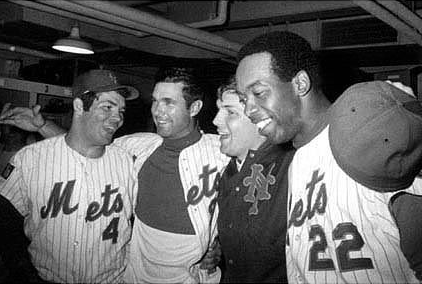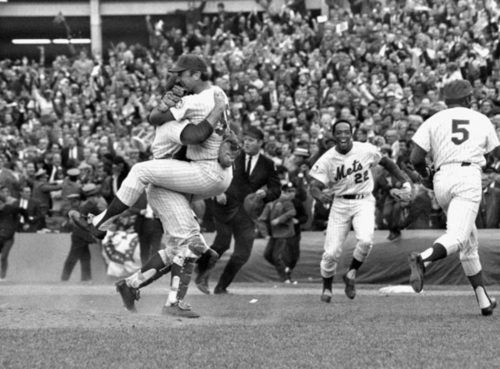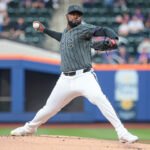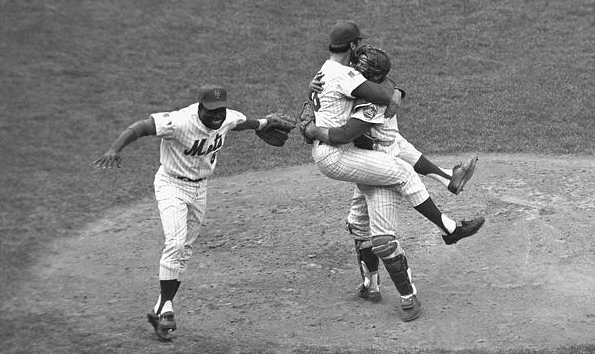
On October 16th, 1969 at Shea Stadium, in front of 57,367 hysterical fans the New York Mets wrote the final chapter of what is still today one of the most compelling “rags-to-riches” stories in Major League Baseball history. A team that for the first seven seasons of their existence had been a laughingstock and the brunt of countless jokes, was suddenly and inexplicably sitting on top of the baseball world. And no one except the Mets and their fans were laughing anymore.
Was it a fluke though? A happy accident? The fact that the Mets made it back to the World Series four years later in 1973, with the same basic core of players proved that ’69 was no accident. No, the 1969 Mets were the beginning of a new kind of Mets team. A playoff challenger. A team that barring extensive injuries could compete for a playoff spot every year. A team that was built with experience and know-how, and great pitching.
Eventually, a power struggle in the inner circles of the Mets hierarchy following the death of GM Johnny Murphy, would result in the ousting of Whitey Herzog, and the emergence of M. Donald Grant as the “top dog” in the baseball structure of the organization. This was the end of the Mets as a contending team.
As M. Donald Grant, who in Whitey Herzog’s own words: “knew nothing about baseball,” went on to destroy the Mets franchise for the next decade, Herzog went to St. Louis to lick his wounds. Of course Herzog, who knew “plenty about baseball,” went on to build a perennial contender and championship team while the Mets were entering their darkest period as a franchise. Those “White Rat” led Cardinals teams ate the Mets lunch practically every season for the next twelve years.
But this piece is intended to illustrate where that first core of championship players emerged from, and who was actually responsible for what? Perhaps by reviewing the history of our own beloved Amazins, we can ourselves relearn what it takes to build a winner. There were three Mets GM’s from the team’s inception in 1961 until the end of that miracle ’69 season. They were each in their own right, very important in building that world champion team.
The first Mets GM was George Weiss, who was tabbed by Mrs. Joan Payson in 1961 as the perfect man for the job of getting this fledgling franchise off the ground. Weiss, who along with Casey Stengel had been forced by the Yankees to retire the previous year, had built the Yankee teams that won all those championships in the 40’s and 50’s. He is also credited for developing the modern-day farm system after he began working for the Yankees in 1932. Weiss built the foundation, the talent, and farm system for the Mets that would produce about two-thirds of that ’69 team.
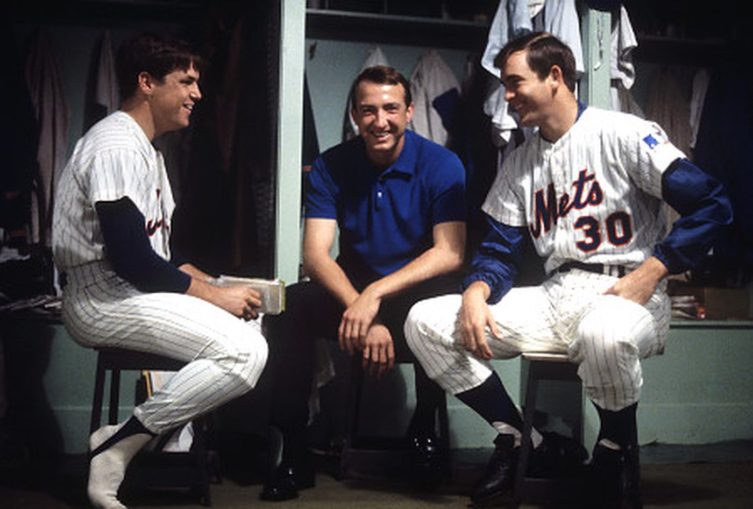
Weiss was directly responsible for acquiring four out of the six starting pitchers the Mets used in 1969, including Tom Seaver who was drafted in a special lottery in 1966, and Jerry Koosman who was signed as an amateur free-agent in 1964. Weiss also made use of the first year of the MLB Amateur Draft in 1965, to take a couple of young hurlers in the 11th and 12th rounds by the names of: Jim McAndrew, and Nolan Ryan. Weiss’ sole contribution to the 1969 bullpen was a young left-hander by the name of Tug McGraw.
As for position players, Weiss had an even more noticeable imprint. Starting of course with the oldest Met, in terms of tender, even in 1969 and still to this day, “Steady” Eddy Kranepool. Krane was signed as an amateur free-agent in 1962, a 17-year-old from the Bronx, and made his big league debut at the end of the ’62 season. He would play the next 18 seasons as a Met.
Kranepool and Koosman were joined by other huge free-agent acquisitions in the years before the Draft was implemented in 1965. Bud Harrelson, Cleon Jones, and Ron Swoboda were all netted as free-agents by Weiss in 1963. Koosman, McGraw and Kevin Collins would follow in ’64. In 1965, not only did Weiss land Ryan, McAndrew, Ken Boswell, and Steve Renko in the draft, he also made a very shrewd trade with Houston to pry a young catcher away from them by the name of Jerry Grote.
The second MLB Draft in 1966 enabled Weiss to land the Mets a promising catcher named Duffy Dyer in the 1st round. In all, twelve players from the World Championship 1969 team were acquired directly by George Weiss, and five more were acquired indirectly, through moves previously made by him. Weiss would eventually be voted into the Baseball Hall of Fame in 1971.
Bing Devine, was scooped up by Joan Payson after he was fired by the Cardinals, and brought in to replace Weiss as GM. He was only in the position for one year, 1967, but during that time he made some very important moves that would end up helping the Mets win a world championship two years later. Devine was caught up in the tug-of-war between Herzog and Grant and decided after just one year he had to get the hell out of there. St. Louis realized they had made a mistake in firing him, so off he went back to the Cardinals where Herzog would join him a short time later.
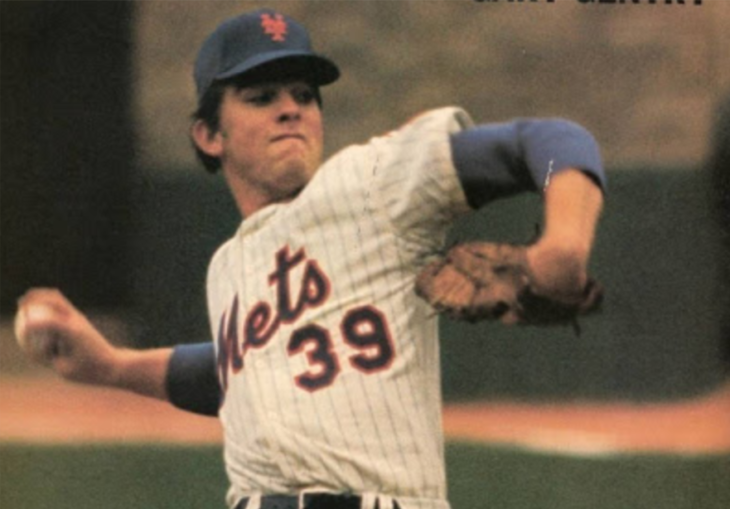
But during the one short year he served as Met GM Devine left an indelible mark on the franchise. In his one draft with the Mets, Devine made a huge selection in the 3rd round when he tabbed a young, fire-balling right-hander, by the name of Gary Gentry. Gentry would break into the bigs in 1969 and pitch so well for the Mets, that he nailed down the number three spot in the rotation. The other notable player from Devine’s ’67 draft was reserve outfielder Rod Gaspar, in the 2nd round.
Devine understood that this team was close to being very, very good, and he was able to add important complimentary pieces without disrupting the team’s nucleus. He either purchased the contracts or traded for, several older but useful role players to fill out the rotation, bullpen, and bench. Players like catcher J.C. Martin, who he traded an aging Ken Boyer to acquire, and would later play a key role in the ’69 Series. Devine picked up third baseman Ed Charles, “The Glider,” from K.C., and important relievers Cal Koonce and Ron Taylor.
He also made two very significant trades. The lesser of the two, which was still crucial to the Mets fortunes in the 1969 season, was the December 1966 trade of RHP Dennis Ribant to the Pittsburgh Pirates for veteran left-hander Don Cardwell. Cardwell came over to the Mets and did an excellent job of rounding out the rotation. Furthermore he provided a veteran influence on a very young rotation whose senior member up to that point was 26-year-old Jerry Koosman, and he clearly took pressure off the youngsters Ryan and Gentry.
The biggest contribution that Devine made was not the player he acquired in the trade where he sent Jim Hickman and Ron Hunt to the L.A. Dodgers. That was outfielder/third-baseman Tommy Davis, and Davis, like Devine, would only work as a Met for the 1967 season. However, Davis would eventually become a key component in a trade for two other players who would be huge for the Mets in 1969. More on that in a little bit.
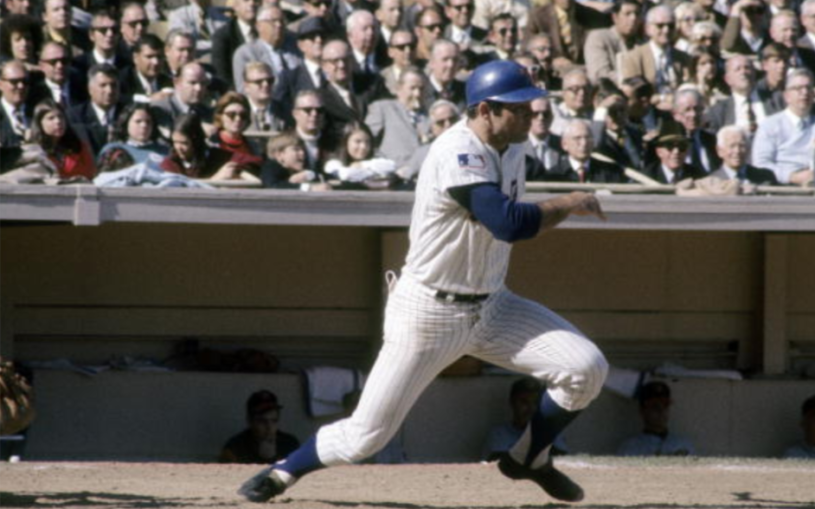
With Devine now gone, enter Johnny Murphy as the franchise’s third GM. Murphy, a former relief ace for the Yankees in the 30’s and 40’s, had been a Red Sox executive for 13 seasons mostly involved in scouting, and started working in the Mets front office in 1961. He was a solid, knowledgeable baseball man who could stand up to the meddling Grant.
Murphy guided the team through 1968 and 1969, and like Devine, knew enough to see that he had the makings of a winning team that only required a little leadership, and a little fine-tuning to really make some noise. It was to this end that Murphy acquired outfielder Art Shamsky from Cincinnati, third baseman Bobby Pfeil from St. Louis, and lefty reliever Jack DiLauro from Detroit.
It was Murphy who pulled off a blockbuster for the Mets when he traded Tommy Davis and unloaded RHP Jack Fisher, and two prospects in 1968, to the White Sox for Tommie Agee and Al Weis. He also selected infielder Wayne Garrett from the Braves in the 1968 Rule 5 Draft. Garrett went on to have a very solid Mets career including playing a big part in the 1969 season. Murphy identified a major power shortage at the infield corners, and brought in slugging first baseman Donn Clendenon during the season in ’69. Big Donn put the finishing touches on the line-up and provided the everyday on-the-field leadership the team so sorely needed.
Although the biggest contribution Johnny Murphy made to the Mets ultimately winning the World Series was a trade he made, it was not a trade for a player. On November 27th, 1967, Murphy traded right-hander Bill Denehy and $100,000 to the Washington Senators for their manager, Gil Hodges. Hodges’ leadership and guidance was perhaps the single most important factor in stabilizing that very young 1969 Mets team and enabling them to bring home the World Championship. Unfortunately that sweet success would be short-lived for Murphy who passed away the following January, just three months after his team had won it all.
